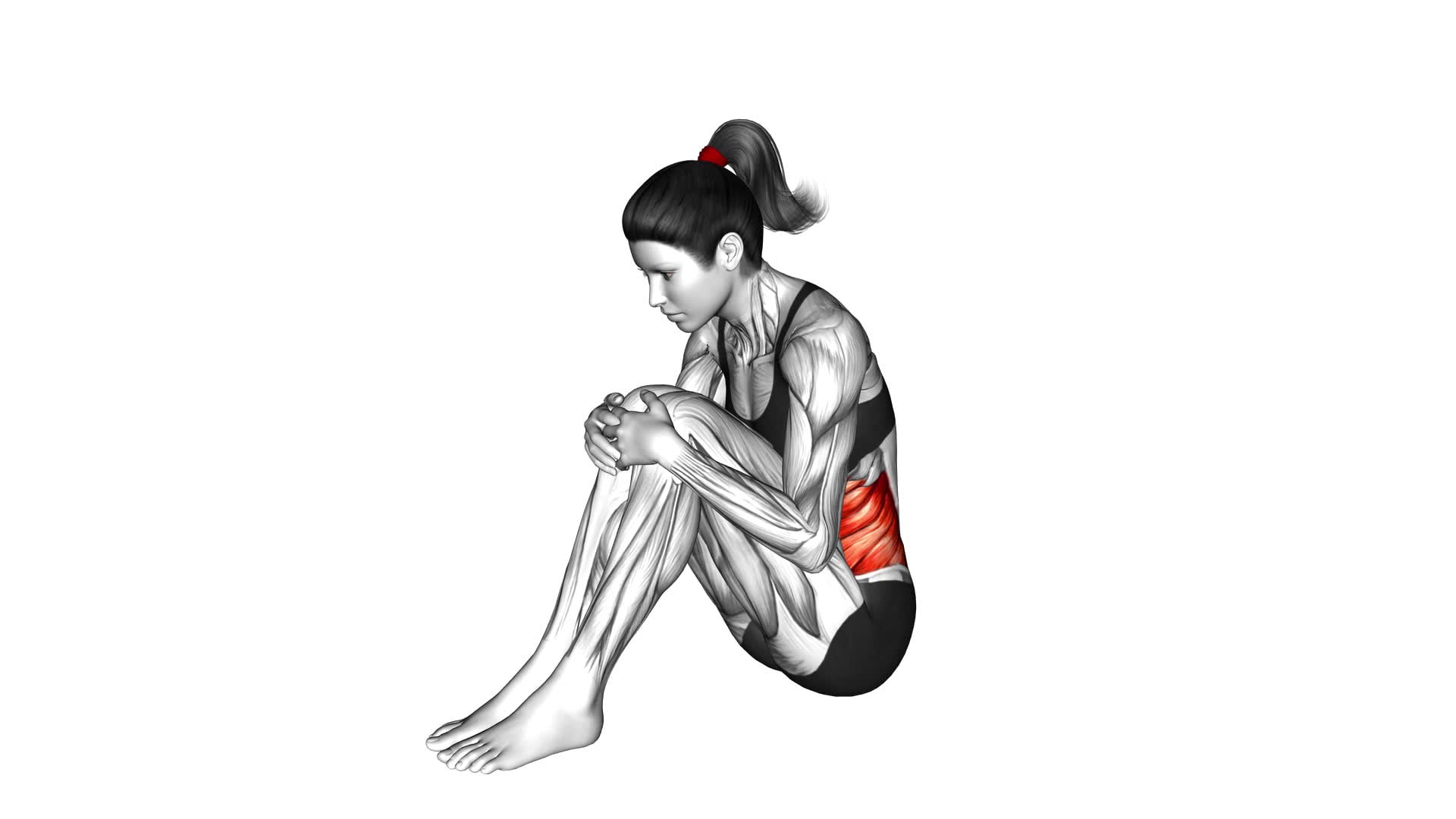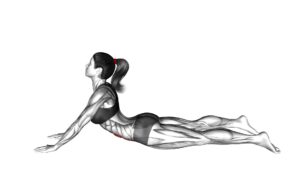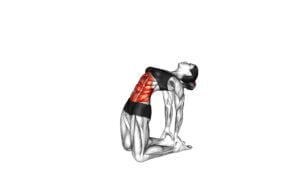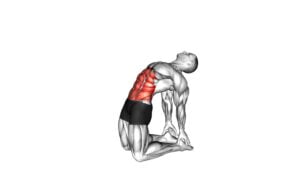Abdominal Stretch (female) – Video Exercise Guide & Tips

Get ready to tone your abs with the abdominal stretch exercise!
Watch This Exercise Video
In this video exercise guide, you'll find tips and techniques to help you achieve maximum results. Avoid common mistakes and learn modifications for different fitness levels.
With our helpful tips, you'll get the most out of this exercise and stay safe while doing it.
So grab a mat, press play, and let's start working on those abdominal muscles!
Key Takeaways
- The abdominal stretch exercise targets abdominal muscles and helps achieve a flatter and more defined midsection.
- Proper form and technique, such as maintaining straight body alignment and engaging core muscles, are important to prevent injury and strain on the back and neck.
- Modifications and progressions can be made to suit different fitness levels, such as starting with bent knees and gradually straightening legs for more challenge.
- Deep breathing during the exercise provides benefits such as increased endurance, muscle activation, flexibility, and stress relief.
Benefits of the Abdominal Stretch Exercise
You can experience several benefits by regularly incorporating the abdominal stretch exercise into your workout routine. This exercise primarily targets your abdominal muscles, helping to strengthen and tone them. By engaging your core, you improve your posture and stability, which can prevent back pain and improve your overall balance. Additionally, the abdominal stretch exercise can help you achieve a flatter and more defined midsection.
One of the great things about the abdominal stretch exercise is its versatility. You can easily modify it to suit your fitness level and goals. For beginners, you can start by performing the exercise with your knees bent and feet on the floor, gradually working your way up to straightening your legs. This allows you to gradually increase the challenge and intensity of the exercise as your core strength improves.
For those looking to progress further, you can incorporate variations such as the standing abdominal stretch or the stability ball abdominal stretch. These modifications not only provide a different challenge to your abdominal muscles but also engage other muscle groups, such as your legs and shoulders.
Incorporating the abdominal stretch exercise into your workout routine can lead to numerous benefits, including improved core strength, posture, and balance. By modifying and progressing the exercise, you can continue to challenge your muscles and achieve even greater results.
Proper Form and Technique for the Abdominal Stretch Exercise
To perform the abdominal stretch exercise with proper form and technique, it's important to focus on correct body alignment, breathe correctly during the exercise, and avoid excessive strain.
Ensure that your body is aligned in a straight line from head to toe, engaging your core muscles throughout the movement.
Remember to breathe deeply and exhale as you stretch, allowing your muscles to relax and extend.
Lastly, listen to your body and avoid pushing yourself too hard, as excessive strain can lead to injury.
Correct Body Alignment
To maintain proper form and technique for the Abdominal Stretch Exercise, ensure that your body's alignment is correct. Here are three important tips to help you achieve the right body posture and muscle activation:
- Keep your spine straight: Align your head, neck, and spine in a neutral position. Avoid arching or rounding your back to prevent strain on the spine.
- Engage your core: Activate your abdominal muscles by pulling your belly button towards your spine. This will help stabilize your torso and protect your lower back.
- Maintain proper shoulder position: Roll your shoulders back and down, away from your ears. This will prevent tension in the neck and upper back, allowing you to focus on the stretch in your abdominals.
Breathing During Exercise
Maintaining proper breathing technique is crucial during the Abdominal Stretch Exercise to enhance muscle activation and improve overall performance. When performing this exercise, it's important to focus on your breath and use specific breathing techniques to maximize its benefits.
Deep breathing helps to oxygenate the muscles and increase their endurance, allowing you to push through the exercise with more strength and stability. Taking slow, controlled breaths ensures that you're engaging your core muscles effectively and maintaining stability throughout the movement.
By coordinating your breath with the stretching motion, you can also enhance your flexibility and range of motion. Proper breathing not only supports your physical performance but also helps to calm your mind and relieve stress.
Avoiding Excessive Strain
To avoid excessive strain during the Abdominal Stretch Exercise, focus on maintaining proper form and technique. Here are three important tips to help you avoid injury and get the most out of your workout:
- Warm up before starting the exercise: It's crucial to prepare your muscles and joints for the abdominal stretch by increasing blood flow and flexibility through a warm-up routine. This can include light cardio exercises like jogging or jumping jacks.
- Engage your core muscles: Proper form is essential for maximizing the benefits of the abdominal stretch and preventing strain. Make sure to engage your core muscles throughout the exercise by pulling your belly button towards your spine and maintaining a straight back.
- Avoid overextending: While it may be tempting to push your limits, it's important to listen to your body and avoid overextending during the abdominal stretch. Gradually increase the intensity and duration of the exercise to prevent excessive strain or injury.
Modifications and Progressions for the Abdominal Stretch Exercise
Your modifications and progressions for the Abdominal Stretch exercise will help you increase flexibility and strengthen your core. When it comes to modifications, there are a few options to consider. If you're new to this exercise or have limited flexibility, you can start by bending your knees slightly. This will reduce the strain on your lower back and allow you to focus on engaging your abdominal muscles. Another modification is to use a prop such as a yoga block or a rolled-up towel under your lower back for support. This will help you maintain proper form and prevent any discomfort.
As you become more comfortable with the Abdominal Stretch exercise, you can progress by straightening your legs and reaching your arms overhead. This will intensify the stretch and challenge your core muscles even more. Another progression is to lift your legs off the ground while maintaining the stretch. This will engage your lower abdominal muscles and increase the difficulty of the exercise.
Remember to listen to your body and only progress when you feel ready. It's important to maintain proper form and avoid any unnecessary strain. By incorporating modifications and progressions into your Abdominal Stretch routine, you can continue to challenge yourself and improve your flexibility and core strength.
Common Mistakes to Avoid During the Abdominal Stretch Exercise
When performing the abdominal stretch exercise, it's important to be aware of common mistakes that can hinder your progress and potentially lead to injury.
One common mistake is incorrect form, which can put unnecessary strain on your back and neck.
Another mistake to avoid is improper breathing technique, as proper breathing helps engage the core muscles more effectively.
Lastly, be cautious not to overstretch, as this can strain the muscles and joints.
Incorrect Form Dangers
While performing the abdominal stretch exercise, it's crucial to be aware of the common mistakes to avoid, in order to prevent incorrect form dangers.
Here are three common mistakes that can put you at risk:
- Arching your back excessively: This can strain your lower back and lead to discomfort or injury. Keep your back straight and engaged throughout the exercise.
- Using momentum instead of control: Swinging your body or using momentum to complete the stretch reduces the effectiveness of the exercise and increases the risk of straining your muscles. Focus on controlled and deliberate movements.
- Neglecting proper breathing technique: Holding your breath or breathing incorrectly during the exercise can increase tension in your muscles and potential risks. Remember to breathe steadily and deeply throughout the stretch.
Proper Breathing Technique
To ensure proper form and avoid potential risks, it's important to focus on maintaining a steady and controlled breathing technique during the abdominal stretch exercise.
Proper breathing technique not only helps to enhance the effectiveness of the exercise, but it also provides several benefits for your body and mind. Deep breathing, which involves inhaling deeply and exhaling fully, can help to oxygenate your muscles and promote relaxation. This can lead to reduced stress levels and increased feelings of calmness.
Deep breathing also helps to improve lung capacity and can enhance your overall endurance during exercise. To incorporate proper breathing technique into your abdominal stretch, take a deep breath in as you stretch your arms overhead, and exhale slowly as you bring your arms back down. Remember to relax and focus on your breath throughout the exercise for optimal results.
Overstretching Risks
To avoid overstretching and potential injuries during the abdominal stretch exercise, focus on maintaining proper form and avoiding common mistakes. Overstretching can have serious consequences, such as muscle strains, sprains, or even tears. By following these tips, you can prevent injuries and get the most out of your workout:
- Avoid excessive arching of your back: Overarching puts unnecessary strain on your lower back and can lead to discomfort or injury. Keep your back flat and engage your core muscles to maintain stability.
- Don't force the stretch: Pushing yourself too far can result in overstretching. Listen to your body and go only as far as feels comfortable. Gradually increase the intensity of the stretch over time.
- Maintain control and stability: It's important to perform the abdominal stretch exercise with control and stability. Avoid jerky movements or bouncing, as this can increase the risk of overstretching and injury.
By following these guidelines, you can prevent overstretching and reduce the risk of injuries during the abdominal stretch exercise.
Transitioning into the next section, let's now discuss some tips for getting the most out of this exercise.
Tips for Getting the Most Out of the Abdominal Stretch Exercise
Get the most out of the abdominal stretch exercise by focusing on proper form and engaging your core muscles throughout. To maximize effectiveness, it's important to maintain a steady breathing pattern and avoid holding your breath. This will help you stay relaxed and allow for a deeper stretch.
Additionally, try incorporating different stretching variations to target different muscles in your abdomen. For example, you can try the seated abdominal stretch, where you sit on the edge of a chair and lean forward, or the standing abdominal stretch, where you stand upright and reach your arms overhead while leaning to one side. These variations can help engage different muscle groups and enhance the benefits of the exercise.
Remember to listen to your body and adjust the intensity of the stretch accordingly. If you feel any pain or discomfort, ease off the stretch or stop altogether. It's important to take care of your body and not push beyond your limits.
Now that you know how to get the most out of the abdominal stretch exercise, let's move on to the next section where we'll discuss important safety precautions to keep in mind while performing this exercise.
Safety Precautions for the Abdominal Stretch Exercise
Before starting the abdominal stretch exercise, ensure you have a stable and comfortable surface to perform the exercise on. Safety should always be a priority when engaging in any physical activity, and the abdominal stretch is no exception.
Here are three important safety precautions to keep in mind:
- Warm up exercises: Before diving into the abdominal stretch, it's crucial to warm up your body properly. This helps to increase blood flow, loosen up your muscles, and prepare your body for the exercise. Incorporate dynamic stretches such as arm circles, leg swings, and torso twists to warm up your entire body.
- Maintain proper form: To avoid injuries, it's essential to maintain proper form throughout the exercise. Keep your back straight, engage your core muscles, and avoid straining your neck. Remember to breathe steadily and avoid holding your breath while performing the stretch.
- Listen to your body: Pay close attention to how your body feels during the exercise. If you experience any sharp or intense pain, stop immediately. It's important to know your limits and not push yourself beyond what feels comfortable. If you're unsure about any aspect of the exercise, consult a qualified fitness professional for guidance.
Frequently Asked Questions
How Many Times a Week Should I Perform the Abdominal Stretch Exercise?
To get the best results from the abdominal stretch exercise, it's important to know how often to perform it.
The frequency of this exercise depends on your fitness level and goals. Generally, it's recommended to incorporate the abdominal stretch into your full body stretching routine 2-3 times a week.
However, advanced practitioners can perform variations of the abdominal stretch more frequently to challenge their core muscles.
Remember to listen to your body and adjust the frequency accordingly.
Can I Do the Abdominal Stretch Exercise if I Have Lower Back Pain?
Can abdominal stretching help relieve lower back pain?
Yes, it can. When done correctly, abdominal stretching can help strengthen the core muscles, which can provide support to the lower back and alleviate pain.
However, it's important to consult with a healthcare professional before starting any exercise routine, especially if you have lower back pain. Additionally, if you're pregnant, it's important to consult with your doctor to determine if it's safe to do abdominal stretching during pregnancy.
Is the Abdominal Stretch Exercise Suitable for Pregnant Women?
During pregnancy, it's important to modify exercises to ensure the safety of both you and your baby. The abdominal stretch exercise may not be suitable for pregnant women, as it involves stretching the abdominal muscles and can put strain on the lower back.
However, there are alternative stretches that can help maintain core strength and flexibility. It's always best to consult with your healthcare provider or a certified prenatal fitness instructor for guidance on exercise modifications during pregnancy.
Can I Do the Abdominal Stretch Exercise if I Have a Hernia?
If you have a hernia, it's important to take precautions when doing the abdominal stretch exercise.
Make sure to consult with your healthcare provider to determine if it's safe for you to do this exercise.
They may recommend modifications or alternative exercises to avoid putting strain on the hernia.
It's crucial to prioritize your safety and follow any guidelines or restrictions given by your healthcare provider to prevent further complications.
How Long Should I Hold the Abdominal Stretch Position for Maximum Benefit?
To maximize the benefits of the abdominal stretch, hold the position for at least 20-30 seconds. This will allow your muscles to fully stretch and increase flexibility.
Incorporating different variations of the abdominal stretch into your daily routine can target different areas of your core and help strengthen your abdominal muscles.
Adding this exercise to your routine can improve posture, reduce lower back pain, and enhance overall core stability.
Conclusion
In conclusion, the abdominal stretch exercise is a beneficial way to improve core strength and flexibility. By maintaining proper form and technique, you can effectively engage your abdominal muscles and enhance your overall fitness.
It's important to avoid common mistakes and make modifications or progressions as needed. Remember to prioritize safety by listening to your body and consulting with a professional if necessary.
With these tips in mind, you can maximize the benefits of the abdominal stretch exercise.

Author
Years ago, the spark of my life’s passion ignited in my mind the moment I stepped into the local gym for the first time. The inaugural bead of perspiration, the initial endeavor, the very first surge of endorphins, and a sense of pride that washed over me post-workout marked the beginning of my deep-seated interest in strength sports, fitness, and sports nutrition. This very curiosity blossomed rapidly into a profound fascination, propelling me to earn a Master’s degree in Physical Education from the Academy of Physical Education in Krakow, followed by a Sports Manager diploma from the Jagiellonian University. My journey of growth led me to gain more specialized qualifications, such as being a certified personal trainer with a focus on sports dietetics, a lifeguard, and an instructor for wellness and corrective gymnastics. Theoretical knowledge paired seamlessly with practical experience, reinforcing my belief that the transformation of individuals under my guidance was also a reflection of my personal growth. This belief holds true even today. Each day, I strive to push the boundaries and explore new realms. These realms gently elevate me to greater heights. The unique combination of passion for my field and the continuous quest for growth fuels my drive to break new ground.







